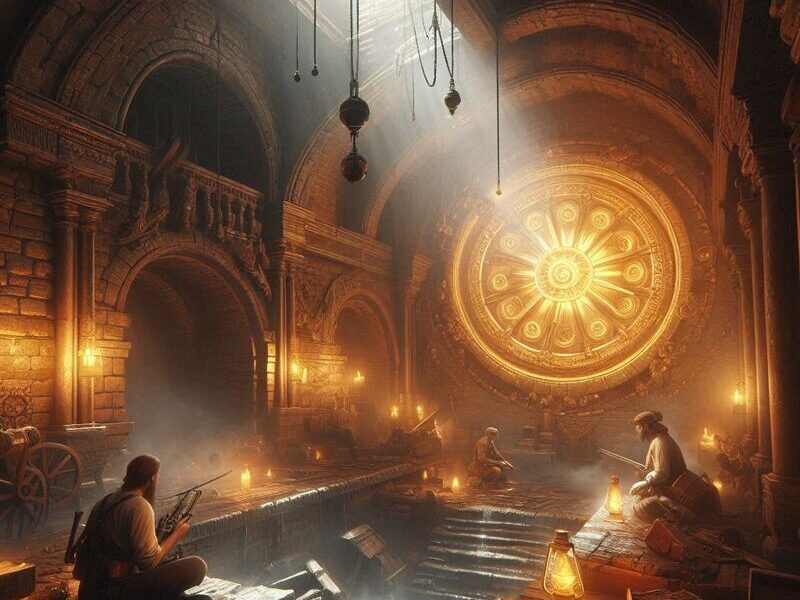Past Pursuits: Delving into the Depths of Historical Gaming
Video games have become a powerful medium for exploring and experiencing history, offering immersive journeys that transport players to bygone eras. “Past Pursuits: Delving into the Depths of Historical Gaming” explores how this genre allows gamers to traverse through time, from ancient civilizations to pivotal moments of the modern age. This series examines how historical games combine entertainment with education, meticulously blending factual events with interactive storytelling to create enriching experiences that resonate well beyond the screen.
Throughout this exploration, we will delve into how game developers research and recreate historical periods, the challenges they face in balancing accuracy with engaging gameplay, and the profound impact these games have on our understanding of history. Whether you are a history buff, a gaming enthusiast, or a curious learner, this series aims to unveil the complexities and attractions of historical gaming, illustrating how these digital worlds both reflect and reshape our perceptions of the past.

Part 1: Crafting Historical Realms in Gaming
Building Accurate Worlds from Ancient Texts to Digital Territories
The journey of creating a historically accurate game world begins with extensive research. Developers pore over historical texts, work with historians, and visit locations to capture the essence of the era they aim to recreate. Games like “Assassin’s Creed: Unity” take players to revolutionary Paris with such detail that it feels like stepping into a living history book. The game not only features landmarks like Notre Dame but also immerses players in the political and social upheavals of the time.
Leveraging Technology to Revive Lost Epochs
Advancements in technology have allowed developers to build more authentic and detailed historical environments than ever before. Using techniques such as 3D scanning and photorealistic rendering, games like “Battlefield 1” recreate the intense and tumultuous ambiance of World War I battlefields, making the experiences feel real and immediate. These technological tools are invaluable in crafting game worlds that are not only visually spectacular but also historically poignant.
Part 2: The Narrative Weave of History and Fiction
Balancing Historical Facts with Creative Liberties
One of the significant challenges in historical gaming is finding the right balance between being faithful to history and creating a game that is fun and engaging. Developers often take creative liberties to ensure that gameplay mechanics and storylines remain appealing and accessible. For example, the “Total War” series combines accurate depictions of historical battles with fictionalized narratives that allow players to experience ‘what if’ scenarios, providing both education and entertainment.
Engaging Players with Dynamic Storytelling
The narrative techniques employed in historical games often involve complex characters and intricate plots that draw heavily from real events and personalities. By doing this, games like “L.A. Noire” not only entertain but also educate players about the social issues and cultural dynamics of post-war America. This dynamic storytelling helps in creating a deeper connection between the player and the historical period depicted.
Part 3: The Role of Historical Games in Education
Learning Through Interactive Experiences
Historical games have found a place in educational settings, thanks to their ability to present history in an interactive and engaging manner. These games serve as virtual field trips, giving students the chance to explore historical sites and events firsthand. Games like “Oregon Trail” have been used for decades to teach students about American pioneers with an engaging approach that textbooks cannot match.
Challenges in Educational Accuracy
While historical games can enhance learning, they also pose challenges in ensuring that the information presented is accurate and appropriate. The simplification of complex historical events to fit game narratives can sometimes lead to misinformation or skewed perspectives, underscoring the need for careful curation when these games are used as educational tools.
Part 4: Ethics and Responsibility in Historical Representation
Navigating Sensitive Historical Themes
The depiction of sensitive historical themes such as wars, colonization, and cultural conflicts requires careful consideration to avoid perpetuating stereotypes or offending players. Games like “This War of Mine” tackle these challenges by focusing on the civilian experience in wartime, providing a fresh perspective that emphasizes human suffering over glorification of conflict.
The Responsibility of Game Developers
As creators of content that shapes perceptions of history, game developers bear a responsibility to handle historical content with respect and accuracy. This responsibility includes not only thorough research but also an ethical approach to game design, ensuring that historical games contribute positively to players’ understanding of the past.
Part 5: Innovations and Future Directions in Historical Gaming
Virtual Reality and the Next Frontier
The potential for virtual reality (VR) in historical gaming is immense, offering a more immersive and interactive way to experience history. VR technologies can transport players directly into the past, allowing them to walk through ancient cities, interact with historical figures, or participate in historical events as if they were there. For instance, imagine a VR experience that brings to life the bustling streets of ancient Rome or the tense atmosphere of a World War II battlefield. Such experiences could revolutionize how we learn about and engage with history, making it a truly sensory journey.
AI and Dynamic Historical Environments
Artificial intelligence (AI) is another area poised to transform historical gaming. AI can be used to create more dynamic and responsive historical environments, where NPCs (non-player characters) behave and react in ways that are true to their historical contexts. This could lead to games where historical figures have their own agendas, personalities, and responses based on the player’s actions, making the game experience more realistic and varied.
Part 6: Diversity and Inclusion in Historical Narratives
Broadening Perspectives with Global Histories
Historical gaming has often been criticized for its Eurocentric focus and the predominance of certain narratives over others. There is a growing push within the industry to broaden these perspectives by incorporating diverse histories from around the world. This includes stories from Africa, Asia, the Americas, and other regions that have been underrepresented in gaming. By doing so, developers not only enrich the historical gaming landscape but also promote a more inclusive understanding of global history.
Representation Matters: Ensuring Cultural Accuracy
As developers explore these diverse histories, the importance of cultural accuracy and respectful representation becomes paramount. This involves working closely with historians, cultural experts, and communities to ensure that the histories and cultures are portrayed authentically and sensitively. Such efforts prevent the perpetuation of stereotypes and foster a greater appreciation for the complexities and richness of different cultures throughout history.
Part 7: Community Engagement and Historical Discourse
Fostering a Community of Historical Enthusiasts
Historical games often foster passionate communities of players who are not only interested in gaming but also in the historical periods depicted. Developers can engage with these communities by hosting forums, discussions, and events that encourage players to delve deeper into the history behind the games. Such engagement can transform players into active participants in historical discourse, contributing to a more dynamic and interactive learning process.
The Role of Critiques and Reviews in Shaping Historical Games
Critiques and reviews play a crucial role in shaping the development of historical games by providing feedback on historical accuracy, narrative depth, and gameplay. Constructive criticism helps developers understand where they might have strayed from historical fidelity or cultural sensitivity, guiding future projects and improvements. This dialogue between the gaming community and developers is vital for the continued growth and refinement of the genre.
Conclusion: The Enduring Legacy of Historical Gaming
Reflecting on “Past Pursuits: Delving into the Depths of Historical Gaming,” it becomes evident that historical games do more than recreate past events; they offer a canvas for reflection, education, and critical engagement. As technology evolves and our understanding of history expands, so too does the potential for these games to educate and inspire. The future of historical gaming holds exciting possibilities for deeper immersion, greater inclusivity, and more active engagement with history, promising to keep this genre vibrant and relevant. As developers continue to push the boundaries of what can be achieved, historical games are set to remain a crucial bridge between the past and the present, helping new generations connect with history in profound and meaningful ways.




